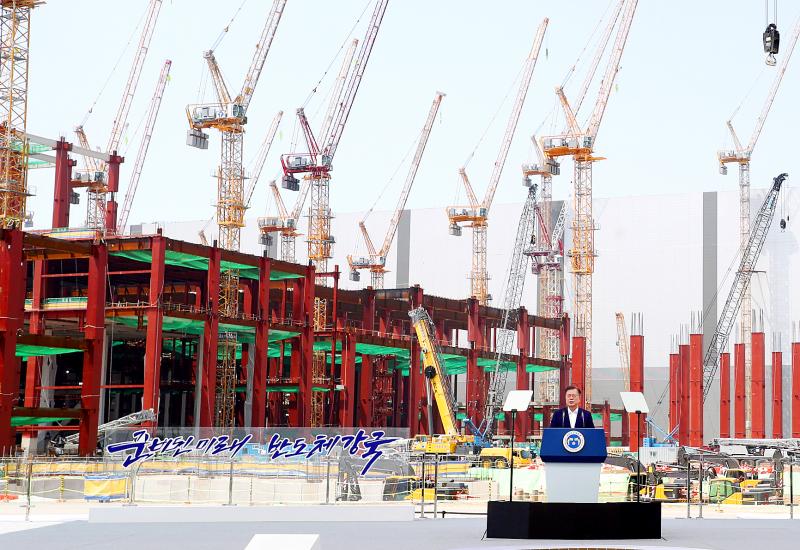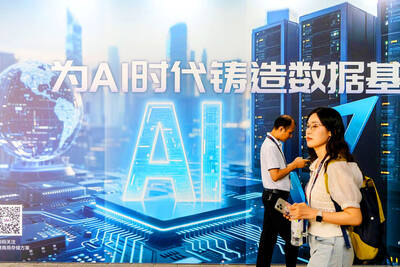South Korea unveiled ambitious plans to spend about 510 trillion won (US$450 billion) to build the world’s biggest chipmaking base over the next decade, joining China and the US in a global race to dominate the key technology.
Samsung Electronics Co and SK Hynix Inc would lead in the investment of 510 trillion won in semiconductor research and production through 2030 under a national blueprint devised by the administration of South Korean President Moon Jae-in.
Samsung and Hynix would be among 153 companies driving the decade-long push, intended to safeguard the nation’s most economically crucial industry.

Photo: EPA-EFE
Yesterday, Moon was briefed by chip executives on the initiative during a visit to the country’s most advanced chip factory, a Samsung plant south of Seoul.
Samsung is boosting its spending by 30 percent to US$151 billion through 2030, while Hynix is committing US$97 billion to expansion at existing facilities, in addition to its US$106 billion plan for four new plants in Yongin, cochief executive officer Park Jung-ho said at the event.
“Major global competitors are pressing ahead with massive investment to be the first to take the future market,” Moon said in a speech. “Our companies have been taking risks and innovating as well, and have completed preparations for tumultuous times.”
The effort comes at a time when the US, China and the EU seek to shore up their semiconductor capabilities after a global chip shortage exposed a reliance on just a handful of Asian manufacturers and hobbled efforts to repair economies scarred by the COVID-19 pandemic.
The shortages are spreading from vehicles to smartphones and displays, elevating semiconductors onto the agendas of governments from Washington to Brussels and Beijing.
At stake is a technology fundamental to groundbreaking advances from artificial intelligence (AI) to autonomous vehicles and connected homes.
South Korea, a security ally of the US and a major exporter to China, has been walking a tightrope between the two, while bolstering its own production prowess.
Semiconductors account for the largest share of South Korea’s exports, and chip exports are expected to double to US$200 billion by 2030, the South Korean Ministry of Trade, Industry and Energy said.
Likening semiconductors to rice — a global dietary staple — the ministry called them “strategic weapons” in a race for superior technology intensifying among not just firms, but also nations.
The government seeks to build a “K-semiconductor belt” that stretches dozens of kilometers south of Seoul and brings together chip designers, manufacturers and suppliers, the ministry said.
Samsung and Hynix make the majority of the world’s memory chips, basic semiconductors that handle storage for all devices, but one area that South Korea has been lagging in is the ability to produce advanced logic chips that handle complex calculations for tasks such as AI and data processing, a specialty dominated by Taiwan Semiconductor Manufacturing Co (台積電), which makes Apple Inc’s iPhone processors.
Samsung aims to compete more aggressively in this area, securing some of Nvidia Corp’s graphics card business and pursuing a bigger share of Qualcomm Inc’s mobile chips. Hynix, too, has announced ambitions to get into logic chips.
The South Korean government would incentivize its domestic industry with tax breaks, lower interest rates, eased regulations and reinforced infrastructure, hoping to see its chipmakers make up the distance from the global leaders, the ministry said.
The government would secure an adequate water supply for the next 10 years in the targeted region and reinforce power supplies, both essential to advanced chipmaking factories.
South Korea also aims to attract additional foreign investment in advanced technology.
Dutch semiconductor equipment maker ASML Holdings NV signaled that it intends to spend 240 billion won to build a training center in Hwaseong, while California-based Lam Research Corp plans to double its capacity in the country, the ministry said.
In terms of direct contributions, the country wants to help train 36,000 chip experts between next year and 2031, contribute 1.5 trillion won toward chip research and development, and would start discussing legislation tailored to assist the semiconductor industry.

Taiwan Semiconductor Manufacturing Co (TSMC, 台積電) last week recorded an increase in the number of shareholders to the highest in almost eight months, despite its share price falling 3.38 percent from the previous week, Taiwan Stock Exchange data released on Saturday showed. As of Friday, TSMC had 1.88 million shareholders, the most since the week of April 25 and an increase of 31,870 from the previous week, the data showed. The number of shareholders jumped despite a drop of NT$50 (US$1.59), or 3.38 percent, in TSMC’s share price from a week earlier to NT$1,430, as investors took profits from their earlier gains

In a high-security Shenzhen laboratory, Chinese scientists have built what Washington has spent years trying to prevent: a prototype of a machine capable of producing the cutting-edge semiconductor chips that power artificial intelligence (AI), smartphones and weapons central to Western military dominance, Reuters has learned. Completed early this year and undergoing testing, the prototype fills nearly an entire factory floor. It was built by a team of former engineers from Dutch semiconductor giant ASML who reverse-engineered the company’s extreme ultraviolet lithography (EUV) machines, according to two people with knowledge of the project. EUV machines sit at the heart of a technological Cold

AI TALENT: No financial details were released about the deal, in which top Groq executives, including its CEO, would join Nvidia to help advance the technology Nvidia Corp has agreed to a licensing deal with artificial intelligence (AI) start-up Groq, furthering its investments in companies connected to the AI boom and gaining the right to add a new type of technology to its products. The world’s largest publicly traded company has paid for the right to use Groq’s technology and is to integrate its chip design into future products. Some of the start-up’s executives are leaving to join Nvidia to help with that effort, the companies said. Groq would continue as an independent company with a new chief executive, it said on Wednesday in a post on its Web

CHINA RIVAL: The chips are positioned to compete with Nvidia’s Hopper and Blackwell products and would enable clusters connecting more than 100,000 chips Moore Threads Technology Co (摩爾線程) introduced a new generation of chips aimed at reducing artificial intelligence (AI) developers’ dependence on Nvidia Corp’s hardware, just weeks after pulling off one of the most successful Chinese initial public offerings (IPOs) in years. “These products will significantly enhance world-class computing speed and capabilities that all developers aspire to,” Moore Threads CEO Zhang Jianzhong (張建中), a former Nvidia executive, said on Saturday at a company event in Beijing. “We hope they can meet the needs of more developers in China so that you no longer need to wait for advanced foreign products.” Chinese chipmakers are in